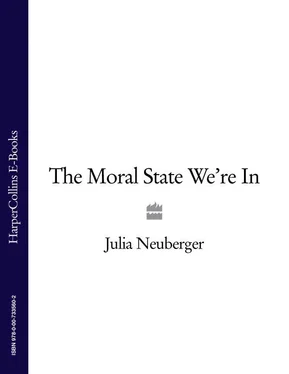So can the NHS do better? Its record in this area is not all that reassuring. An inquiry by the Health Advisory Service in 2000 † demonstrated that older people were less satisfied with the care they received than younger people-which is surprising given that older people complain less than younger people. They experienced unacceptably long delays in admission, problems with feeding and with the physical environment, staff shortages, privacy and dignity, communication with staff, and, most profoundly, with staff attitudes towards older people. The recommendations were lengthy, but the most significant was that everyone-patients, relatives, and staff-has to take on responsibility for challenging negative attitudes about old age, about prospects for recovery, and about worth. So if the NHS has problems of this sort, will voluntary organizations take on the provision of care homes? Many already do, particularly those that are religiously or ethnically based. The mess in care home provision has come about as a result of inadequate planning and a cross-party agreement to shift the burden of care to the private sector. But the position is untenable. The risks of abuse would not be not hugely improved, and feelings of insecurity would remain.
An inquiry into the care market in London currently being carried out by the King’s Fund shows that there are still concerns about a number of familiar issues. For example, there is a very limited choice of care and support for older people. While there is no evidence of insufficient care home places for older Londoners, these may not always be where people want them; and there certainly is a shortage of services for older people with mental health problems such as dementia. The King’s Fund has also found that throughout London there are difficulties in recruiting and retaining nurses, social workers, therapists, and care workers. Older people’s views of services have been shown to be varied; some are very appreciative of a wide range of services, but there are widespread concerns about the quality of home care and residential care services. All of this is compounded by financial pressures, for in spite of increased government spending councils have to juggle the needs of older people with other priorities.
Though inspection of care homes has led to the uncovering of some abuse, inspection in itself is not enough: in fact the burden of inspection and regulation on an already precarious nursing and care home sector may make even more owners give up. Part of the answer lies in allowing ordinary people to visit older people in nursing or care homes, as part of a daily or weekly routine. However, the Better Regulation Task Force, a government body, warned that vital care services were being withdrawn precisely because of inflexible ‘no touch’ rules stopping volunteers taking older and disabled people to the bathroom or feeding them. *Indeed, volunteers, often in their sixties or seventies themselves, the so-called Third Agers, are now often subjected to the same training requirements for a few hours of help as professional care workers. The report was the work of a committee chaired by Sukhvinder Stubbs, who argued that small local agencies who work with volunteers are being affected by ‘silly regulation, bonkers regulation’. But the issue is really about the level of risk service users want to accept-for instance, the extent to which they want to be able to choose the temperature of their own bath water.
In the present climate we are automatically suspicious of people wanting to visit nursing homes and care homes on a casual, uninvited basis. Who are they? Are they would-be abusers? Are they after the older people’s money? Yet this attitude of mistrust, and the now ubiquitous fear of risk, may well be leading to a greater degree of isolation for residents. The more we close off institutions, the less we know what is going on within them, the easier it is for abuse to take place and for the residents to feel isolated, hopeless, and forgotten. Some system whereby lonely older people get visited on a regular basis needs to be taken up by a whole variety of organizations, from schools and colleges to churches and mosques, from Townswomen’s Guilds to Working Men’s Clubs. This sense of isolation, and the fear that taking an interest in older people will be seen as perverse, must stop.
A few schemes exist, such as the excellent British Red Cross’s Home from Hospital scheme, which has some 55 initiatives operating nationwide, but many more are needed. The Red Cross model gets round the issue of strangers coming in to people’s homes because the volunteers are trained and supported and the service is paid for by local social service departments. This model of supported, trained volunteers who do it because they love it, supported by professional volunteer co-ordinators and a serious, respected organization like the Red Cross, gives older people the confidence to use the service, gives volunteers the feeling that they will not be rejected by the people they visit, since the Red Cross badge will be seen as a mark of quality and safety, and makes the system run as a truly voluntary service with rigorous quality and safety checks. *It is this kind of service that we need to see nationwide, with an expectation that most of us, if not in need of such support ourselves, should be taking part in providing it under the auspices of a respected, sensible organization. Such a model of practical help combined with care and companionship would make all the difference to the isolation and fear felt by many older people.
Another enormous issue is one that will run throughout this book: the low status, low pay, and generally poor conditions and training of those who provide care for the elderly and other vulnerable groups. Over the last thirty years or more we have seen the professionalization of nursing. Nurses are now university graduates whose training has made them technically very proficient. At the same time, they are often unskilled in basic hands-on procedures, which are increasingly undertaken by care assistants whose training is often minimal and whose security of tenure, and relationship with other members of staff, tends to be poor.
This is a complex issue. Originally, health professionals–particularly nurses–had their hierarchy modelled on the military. After the Second World War nurses came to see themselves as being on an equal footing with doctors. The result has been that nurses’ status has risen. The former slave labour demanded of student nurses has, by and large, disappeared, and student nurses are now spending a great deal more time actually studying. There has, however, been a downside to this. Nurses no longer provide the discipline and structure of a ward or a hospital in the way that they used to do; in addition, routine tasks such as emptying bed pans, giving patients their meals, or turning them and making them comfortable in bed has been handed ‘down’ to care assistants. Nurses are now too expensive a resource to be allowed to feed patients, make beds, or plump up pillows and are too busy giving drugs and injections to empty bedpans. Nor have they been trained to talk to patients and find out what is really worrying or concerning them.
All this is a cause for deep concern, because so many patients will be older people whose recovery rate will be slower than that of younger people and who will inevitably be worried about what will happen to them when they leave hospital. Many will not be fit to go home. Many will be classed as ‘bed blockers’, as if it were their fault that they have nowhere to go and not that of the system that has failed them by not supplying enough nursing home and care home beds. Nurses could be the ones who listen to the fears of elderly patients, who reassure and comfort, who try to speed up social services, who use their position to get things done–and often they are. But because they have so much less hands-on experience than in former times, because they have not been routinely talking to their older patients as they help them eat, or change, or wash, or make their beds, they often do not have the closeness, the intimacy–in its true sense–with their patients that could be used to allay some of these fears.
Читать дальше






![Nicholas Timmins - The Five Giants [New Edition] - A Biography of the Welfare State](/books/701739/nicholas-timmins-the-five-giants-new-edition-a-thumb.webp)





